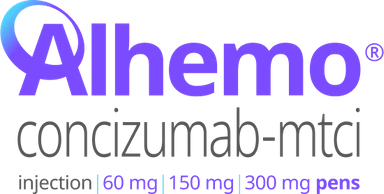Routine prophylaxis treatment in a prefilled, subcutaneous pen to prevent or reduce the frequency of bleeding episodes in adult and pediatric patients 12 years of age and older who have hemophilia B and A with or without inhibitors
Safety demonstrated in the explorer studies1
Alhemo® is backed by strong clinical evidence, including explorer8 and explorer7, trials that investigated the safety and efficacy of Alhemo® for patients with hemophilia B and A with and without inhibitors.
Most common adverse reactions (≥5%) were injection site reactions, headache, and urticaria1
NO
routine liver
monitoring required1


NO
boxed warning1
Safety established
in all hemophilia types1
475
patient-years of exposure
320
patients, with HA and HB with and without inhibitors received at least 1 dose of Alhemo® prophylaxis

In the explorer8 study:
66
males with HB received at least 1 dose of Alhemo® as routine PPx1
Patients’ weights in the study ranged from 37.2 kg (82 lb) to 132.5 kg (298 lb).2
The most frequently reported adverse reactions in patients with HA and HB randomized to receive Alhemo® (incidence ≥5%) were injection site reactions (7%) and headache (7%).1,a


Majority of injection site reactions were mild.3
In explorer8, the safety data reflect exposure of 63 patients with HA and HB who were previously treated with on-demand therapy and who were randomized to arm 1 to receive on-demand treatment with factor product (n=21) or arm 2 to receive Alhemo® PPx (n=42) at the recommended dosing regimen. The median duration of treatment was 24.1 weeks (range 23.6, 56.1 weeks) in arm 1 (on-demand arm) and 32.1 weeks (range 3.9, 33.6 weeks) in arm 2 (Alhemo® PPx).1
aInjection site reactions included: injection site reaction, injection site rash, and injection site nodule.
HA=hemophilia A; HB=hemophilia B; PPx=prophylaxis; TE=thromboembolic event.
0 TEs
in explorer7,
after trial restart4,b


NO
routine liver
monitoring required1


NO
boxed warning1
1.9% (6/320) of patients in Alhemo® clinical trials reported venous and arterial TEs. Cases occurred in patients with multiple risk factors for thromboembolism, including high doses or prolonged treatment with factor product or BPAs (2 of 6 events).
1.9% (6/320) of patients in Alhemo® clinical trials reported venous and arterial TEs. Cases occurred in patients with multiple risk factors for thromboembolism, including high doses or prolonged treatment with factor product or BPAs (2 of 6 events).
Safety established
in studies including all hemophilia types1
475
patient-years of exposure
320
patients with HA with and without inhibitors and HB with and without inhibitors received at least 1 dose of Alhemo® prophylaxis

In the explorer7 study:
133
males with inhibitors received at least 1 dose of Alhemo® as routine PPx1
Patient's weights in the study ranged from 31.2 kg (68.6 lb) to 127.1 kg (279.6 lb).3
In patients randomized to receive Alhemo®:
The most frequently reported adverse reactions (incidence ≥5%) were injection site reactions (18%) and urticaria (6%).1,c


Majority of injection site reactions were mild.4
Dosage interruptions of Alhemo® due to an adverse reaction occurred in 1 patient (3%) and was a hypersensitivity reaction.1
52 patients with HAwI and HBwI and were previously treated with on-demand therapy and were randomized in explorer7 to arm 1 to receive on-demand treatment with BPAs (n=19) or arm 2 to receive Alhemo® PPx (n=33) at the recommended dosing regimen. The median duration of treatment was 31.1 weeks (range 3.9, 72.9 weeks) in arm 1 (on-demand arm) and 40.1 weeks (range 3.1, 56.3 weeks) in arm 2 (Alhemo® PPx).
bThe explorer7 and explorer8 clinical trials were temporarily paused because 3 patients experienced 5 nonfatal TEs. In response, a plan was put in place that included deploying a test to measure concizumab-mtci levels in order to individualize dosing, as well as guidance around how to treat breakthrough bleeds.1,3
cInjection site reactions included: injection site bruising, injection site erythema, injection site hematoma, injection site hemorrhage, injection site reaction, and injection site urticaria.
Urticaria included: urticaria and injection site urticaria.
BPA=bypassing agent; HA=hemophilia A; HAwI=hemophilia A with inhibitors; HBwI=hemophilia B with inhibitors; PPx=prophylaxis; TE=thromboembolic event.
Individualized dosing
Watch Alhemo® in action
Alhemo® is the 1st and only TFPI antagonist for hemophilia with and without inhibitors5
Important Safety Information for Alhemo®
Contraindications
- Alhemo® is contraindicated in patients with a history of known serious hypersensitivity to Alhemo® or its ingredients
Warnings and Precautions
- Thromboembolic Events (TEs): Venous and arterial TEs were reported in 1.9% of patients (6/320) who also had multiple risk factors, including the use of high doses or prolonged treatment with factor product or bypassing agent (2 of 6 patients). Risk factors for TEs may also include conditions in which tissue factor is overexpressed (eg, atherosclerotic disease, crush injury, cancer, disseminated intravascular coagulation, thrombotic microangiopathy, or septicemia). Inform patients about and monitor them for signs and symptoms of TEs. In case of suspicion of TEs, discontinue Alhemo® and initiate further investigations and management strategies
- Hypersensitivity Reactions: Alhemo® is contraindicated in patients with a history of known serious hypersensitivity to Alhemo® or its ingredients. Hypersensitivity reactions, including erythema, rash, pruritus, and abdominal pain, have occurred in patients treated with Alhemo®. One patient (<1%) experienced anaphylaxis, which resolved after treatment with antihistamines and corticosteroids. Instruct patients of the signs of acute hypersensitivity reactions and to contact their healthcare provider for mild reactions and to seek urgent medical attention for moderate to severe reactions. Discontinue Alhemo® if severe hypersensitivity symptoms occur and initiate medical management
- Increased Laboratory Values of Fibrin D-dimer and Prothrombin Fragment 1.2: Increased levels of fibrin D-dimer and prothrombin fragment 1.2 were seen in 29 (9.1%) and 26 (8.1%) patients, respectively, which is positively correlated with the plasma concentration of concizumab-mtci, indicating a hemostatic effect. For patients taking Alhemo®, these coagulation biomarkers may not be reliable predictive markers for clinical decision-making with suspicion of thrombosis, such as deep vein thrombosis and pulmonary embolism
Adverse Reactions
- The most frequently reported adverse reactions (≥5%) were injection site reactions, headache, and urticaria
- Serious adverse reactions were reported in 6.1% of patients with inhibitors who received Alhemo®. Permanent discontinuation of Alhemo® occurred in 1 patient due to a renal infarct and dosage interruptions of Alhemo® occurred in 1 patient (3%) and was a hypersensitivity reaction
Drug Interactions
- Breakthrough Bleeding Treatment: Take appropriate precautions when treating breakthrough bleeding events in patients receiving Alhemo® prophylaxis and FVIII or FIX or a bypassing agent (eg, rFVIIa or aPCC). For mild and moderate bleeds, the lowest approved dose in the approved product labeling is recommended. For aPCC, a maximum dose of 100 units/kg within 24 hours is recommended. For severe bleeds, follow the dosing instructions in the approved labeling based on clinical judgment
Please click here for Alhemo® Prescribing Information.
Indications and Usage
Alhemo® (concizumab-mtci) injection 60 mg, 150 mg, or 300 mg is indicated for routine prophylaxis to prevent or reduce the frequency of bleeding episodes in adult and pediatric patients 12 years of age and older with hemophilia A or B with or without Factor VIII or IX inhibitors.
Important Safety Information for Alhemo®
Contraindications
- Alhemo® is contraindicated in patients with a history of known serious hypersensitivity to Alhemo® or its ingredients
Warnings and Precautions
- Thromboembolic Events (TEs): Venous and arterial TEs were reported in 1.9% of patients (6/320) who also had multiple risk factors, including the use of high doses or prolonged treatment with factor product or bypassing agent (2 of 6 patients). Risk factors for TEs may also include conditions in which tissue factor is overexpressed (eg, atherosclerotic disease, crush injury, cancer, disseminated intravascular coagulation, thrombotic microangiopathy, or septicemia). Inform patients about and monitor them for signs and symptoms of TEs. In case of suspicion of TEs, discontinue Alhemo® and initiate further investigations and management strategies
- Hypersensitivity Reactions: Alhemo® is contraindicated in patients with a history of known serious hypersensitivity to Alhemo® or its ingredients. Hypersensitivity reactions, including erythema, rash, pruritus, and abdominal pain, have occurred in patients treated with Alhemo®. One patient (<1%) experienced anaphylaxis, which resolved after treatment with antihistamines and corticosteroids. Instruct patients of the signs of acute hypersensitivity reactions and to contact their healthcare provider for mild reactions and to seek urgent medical attention for moderate to severe reactions. Discontinue Alhemo® if severe hypersensitivity symptoms occur and initiate medical management
- Increased Laboratory Values of Fibrin D-dimer and Prothrombin Fragment 1.2: Increased levels of fibrin D-dimer and prothrombin fragment 1.2 were seen in 29 (9.1%) and 26 (8.1%) patients, respectively, which is positively correlated with the plasma concentration of concizumab-mtci, indicating a hemostatic effect. For patients taking Alhemo®, these coagulation biomarkers may not be reliable predictive markers for clinical decision-making with suspicion of thrombosis, such as deep vein thrombosis and pulmonary embolism
Adverse Reactions
- The most frequently reported adverse reactions (≥5%) were injection site reactions, headache, and urticaria
- Serious adverse reactions were reported in 6.1% of patients with inhibitors who received Alhemo®. Permanent discontinuation of Alhemo® occurred in 1 patient due to a renal infarct and dosage interruptions of Alhemo® occurred in 1 patient (3%) and was a hypersensitivity reaction
Drug Interactions
- Breakthrough Bleeding Treatment: Take appropriate precautions when treating breakthrough bleeding events in patients receiving Alhemo® prophylaxis and FVIII or FIX or a bypassing agent (eg, rFVIIa or aPCC). For mild and moderate bleeds, the lowest approved dose in the approved product labeling is recommended. For aPCC, a maximum dose of 100 units/kg within 24 hours is recommended. For severe bleeds, follow the dosing instructions in the approved labeling based on clinical judgment
Please click here for Alhemo® Prescribing Information.
Indications and Usage
Alhemo® (concizumab-mtci) injection 60 mg, 150 mg, or 300 mg is indicated for routine prophylaxis to prevent or reduce the frequency of bleeding episodes in adult and pediatric patients 12 years of age and older with hemophilia A or B with or without Factor VIII or IX inhibitors.
References:
- Alhemo [package insert]. Plainsboro, NJ; Novo Nordisk Inc.
- Data on file. Novo Nordisk Inc; Plainsboro, NJ
- Chowdary P, Angchaisuksiri P, Apte S, et al. Concizumab prophylaxis in people with haemophilia A or haemophilia B without inhibitors (explorer8): a prospective, multicentre, open-label, randomised, phase 3a trial. Lancet Haematol. 2024;11(12):e891-e904
- Matsushita T, Shapiro A, Abraham A, et al. explorer7 Investigators. Phase 3 trial of concizumab in hemophilia with inhibitors. N Engl J Med. 2023;389(9):783-794.
